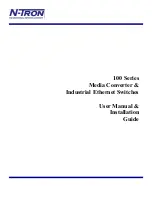
17
Product Documentation and Compliance for the Cisco IE 5000 Switches—
Documentation produit et conformité pour les commutateurs Cisco IE 5000
78-100604-01
Note
The power-supply module 1 connection is labeled PSU1, and the power-supply module 2 connection is
labeled PSU2. Make sure that you connect the wires to the correct terminal screws.
Step 3
Use twisted-pair copper wire (18- to 14-AWG or 0.82- to 2.08-mm
2
) to connect from the power-input
terminal to the power source.
Note
Use 12-AWG or 3.31-mm
2
(minimum) for the low-voltage DC power supply module. Use
16-AWG or 1.31-mm
2
(minimum) for the high-voltage AC or DC power supply module.
Step 4
Strip each of the two wires to 0.25 inch (6.3 mm) ± 0.02 inch (0.5 mm). Do not strip more than 0.27 inch
(6.8 mm) of insulation from the wire. Stripping more than the recommended amount of wire can leave
exposed wire from the connector after installation.
Figure 1-15
Stripping the Input Power Source Wire
Step 5
Insert the wire into a spade terminal, and crimp it to the wire. You can also use a ring or flanged spade
terminal as listed in the
“Equipment That You Need” section on page 7
.
Figure 1-16
Crimping the Spade Terminal Lug
Step 6
Loosen the terminal screw, and slide the terminal under the screw and washer. See
.
Note
Use the appropriate terminal screws, depending on whether you are installing a high-voltage (AC or DC)
or a low-voltage (DC) power supply.
5
PSU1 (power-supply module 1)
12
PSU2 (power-supply module 2)
6
Positive connection for low-voltage DC
(PSU1)
13
Positive connection for low-voltage DC
(PSU2)
7
Negative connection for low-voltage DC
(PSU1)
14
Negative connection for low-voltage DC
(PSU2)
0.25 in. (6.3 mm) ± 0.02 in. (0.5 mm)
60531
207427
















































